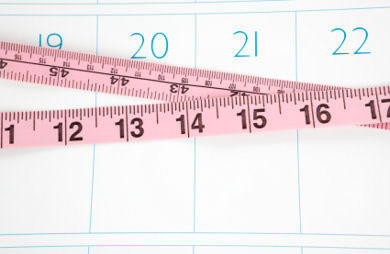|
When someone asks me whether X, Y or Z counts as "exercise" or "cardio," my first response is always, "Well, what does your heart rate tell you?" Measuring your heart rate is an important action for every exerciser. It lets you know how hard you're working during cardio, as different heart-rate levels have different training and fitness benefits. It tells you whether your activity session really "counts" (too low of a heart rate doesn't provide the benefits of aerobic fitness, and heart rates that are too high can be problematic). It can even provide clues that you're overtraining or coming down with an illness (high heart rates at lower exertion levels can are a sign that something's not right). There is a variety of ways to calculate your individual target heart rate for exercise. Getting tested at a university lab or medical center by way of a graded maximal exercise test is the gold standard, but since that's not accessible, safe or feasible for everyone, some standard formulas were created based on the available research at the time. However, a new study from Northwestern Medicine in Chicago says that the formulas experts have used for years to help people calculate their heart rates for exercise aren't accurate at all for women. Researchers collected maximum heart rate date from approximately 5,500 healthy women between the ages of 35 and 93 during maximal graded exercise treadmill tests (the gold standard), and then followed the women for 16 years. While they were initially searching for a link between abnormal heart responses and heart attack risk, the researchers were able to use the data collected to generate a new formula for maximum heart rate in women. It's no secret that a lot of the health, fitness and wellness information we have is based on research and that for a very long time, women were not even studied at all. We didn't know back then that you couldn't just apply the same results found in men to women, just as we didn't realize that different ages and racial and ethnic backgrounds could also alter the outcomes of research studies. The standard max heart rate formula (220 minus age) was based on generalizations from 10 studies done several years ago on men alone, but it's been applied to men and women of all ages for decades now. I've always been somewhat skeptical of that generalized formula, since it assumes one's maximal heart rate declines with age and that one should work out less intensely with each year they celebrate another birthday. That doesn't make a lot of sense if you think about, and surely can't be the case for everyone. SparkPeople has always advocated the use of another formula that is touted among fitness professionals as being more accurate (although slightly more complex): the Karvonen heart rate formula. It's more accurate because it considers a person's resting heart rate (a good indicator of fitness level) when coming up with heart rate guidelines for exercise. The new formula developed by the Chicago researchers who conducted this study says that a women's max heart rate should be calculated as 206 minus 88% of a woman's age. That's not as easy to remember, but its results are said to be more accurate for women, according to these researchers. It also results in lower heart rate ranges for aerobic fitness benefits. I wanted to conduct my own little experiment to see how the outcomes of all three of these heart rate formulas pan out, using myself (an almost 28-year-old) as the example.
While these ranges don't seem strikingly different at a glance, there is a large range between the lowest (100 bpm) and highest (175 bpm) numbers. Just a few beats per minute can feel like a major difference when you're exercising. You can see a large difference between my Karvonen results and the new formula, but keep in mind that the former also factors in my own resting heart rate level (about 60 bmp), so not every 28-year-old would have the same results. Dr. Martha Gulati who led the study told the New York Times that, "There’s nothing wrong with achieving a higher heart rate with exercise, and if you can maintain that, it’s fine." She also said that some women might have had a hard time reaching the heart rates recommended by the standard formula—but perhaps they didn't need to! In my opinion, that makes exercise and achieving its benefits a little less daunting for beginners or people with physical challenges—no more frustration at working hard but not seeing your heart rate reach the recommended levels you were seeking based on a misapplied formula. What this Means for You Keep in mind that this is a single study, and while some are hailing it as the most accurate study to date of women's heart rates during exercise, I have not yet seen any official changes in recommendations from exercise organizations such as The American College of Sports Medicine. This study may change what fitness professionals recommend, but it's too early to jump to that conclusion yet. We'll wait and see if other exercise organizations change their recommendations before we alter our own. What is interesting is that lower heart rates do seem to contribute to aerobic fitness benefits in women, if this study is any indication. That coincides with a growing body of research that says even low-intensity activity provides a multitude of health and fitness benefits, even if it doesn't push your heart rate sky high. Just as the findings of one study on men can't always apply to women, the findings of this study may or may not apply to you. Put simply, these are averages based on the women in this study and they may not work for everyone. Heart rate formulas, calorie calculations, BMI—whatever the recommended levels are, they are still generalizations for the average population. We are all individuals and some of us may not fit into the standard. We are all an experiment of one, as Coach Nancy often says. I've had many students in my classes ask me about their target heart rate ranges, some saying that they use these formulas but the results seem either too high or too low for them. My answer: You're probably right! I like to use a combo of formulas and RPE (Rate of Perceived Exertion) to help people achieve the proper exercise intensity, and that is exactly what the American Council on Exercise recommends as well. If your heart rate says you're working at 90% of your max (super intense!) but it feels like a walk in the park to you, then the formula probably isn't accurate—for you. Some people may have to tweak things here or there to find the right ranges for them. For women who have been trying your darndest to reach a specific heart rate level, but find it too tiring or impossible to get there, this newer formula, which results in lower heart rate ranges, might be a good one to try. Personally, I'll stick with the Karvonen formula for now, but I won't discount low-intensity activity in my day as being useless. According to this formula at least, I'm working harder than I realized! Do you measure your heart rate during exercise? What do you think about the results of this new study? Will it change how you exercise or how you calculate your own target heart rate? |
More From SparkPeople
|





.jpg)









